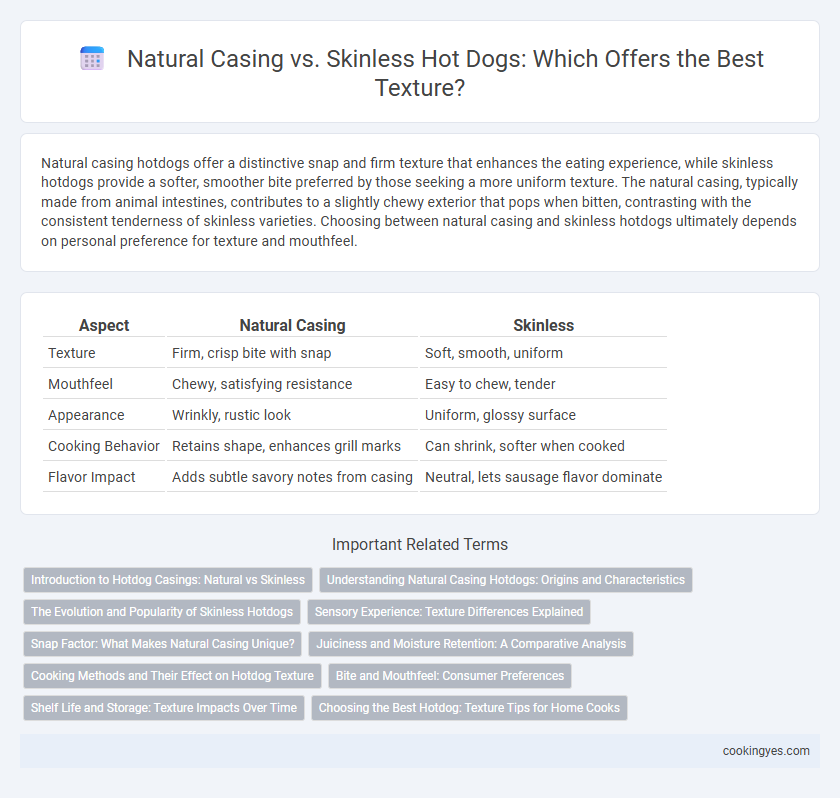Natural casing hotdogs offer a distinctive snap and firm texture that enhances the eating experience, while skinless hotdogs provide a softer, smoother bite preferred by those seeking a more uniform texture. The natural casing, typically made from animal intestines, contributes to a slightly chewy exterior that pops when bitten, contrasting with the consistent tenderness of skinless varieties. Choosing between natural casing and skinless hotdogs ultimately depends on personal preference for texture and mouthfeel.
Table of Comparison
| Aspect | Natural Casing | Skinless |
|---|---|---|
| Texture | Firm, crisp bite with snap | Soft, smooth, uniform |
| Mouthfeel | Chewy, satisfying resistance | Easy to chew, tender |
| Appearance | Wrinkly, rustic look | Uniform, glossy surface |
| Cooking Behavior | Retains shape, enhances grill marks | Can shrink, softer when cooked |
| Flavor Impact | Adds subtle savory notes from casing | Neutral, lets sausage flavor dominate |
Introduction to Hotdog Casings: Natural vs Skinless
Natural casings for hotdogs, made from animal intestines, provide a distinctive snap and a traditional, chewy texture that enhances the eating experience. Skinless hotdogs, created without casings, offer a smoother, uniform texture preferred for their ease of bite and consistent softness. The choice between natural and skinless casings significantly impacts the hotdog's mouthfeel, cooking behavior, and overall consumer preference.
Understanding Natural Casing Hotdogs: Origins and Characteristics
Natural casing hotdogs, traditionally made from cleaned animal intestines, offer a distinctive snap and juicier texture that enhances the eating experience compared to skinless varieties. Originating from European sausage-making techniques, these casings contribute a unique chewiness and allow smoke and spices to permeate better during cooking. Their porous nature also helps retain moisture, making natural casing hotdogs a preferred choice for authentic, flavorful hotdogs.
The Evolution and Popularity of Skinless Hotdogs
Skinless hotdogs have evolved to meet consumer demand for a smoother texture and convenience in preparation, contrasting with the traditional natural casing hotdogs that offer a distinctive snap and firmer bite. The rise in popularity of skinless hotdogs is driven by their uniformity, ease of eating, and compatibility with various cooking methods, making them a favored choice for mass production and fast food venues. Innovations in processing technology have enhanced the consistency and flavor retention of skinless hotdogs, solidifying their place in modern culinary preferences.
Sensory Experience: Texture Differences Explained
Natural casing hotdogs offer a distinctive snap and firmer bite due to the collagen or hog gut casing, enhancing the sensory experience with a satisfying crunch. Skinless hotdogs provide a smoother, softer texture that melts more easily in the mouth, appealing to those who prefer a tender, uniform bite. The choice between natural casing and skinless directly impacts texture perception, influencing overall enjoyment based on individual palate preference.
Snap Factor: What Makes Natural Casing Unique?
Natural casing hotdogs offer a distinctive snap factor due to their edible collagen or animal intestine casings, providing a satisfying, crisp bite that contrasts with the softer, uniform texture of skinless hotdogs. This unique texture enhances the overall eating experience by delivering a noticeable resistance when bitten, which is absent in skinless varieties made from synthetic or cellulose casings. The natural casing's ability to retain juices while offering that signature snap makes it a preferred choice for connoisseurs seeking authentic hotdog texture.
Juiciness and Moisture Retention: A Comparative Analysis
Natural casing hotdogs offer superior juiciness and moisture retention due to their collagen-based outer layer, which locks in internal juices during cooking. Skinless hotdogs lack this natural barrier, often resulting in a drier texture and less satisfying bite. The natural casing's ability to prevent moisture loss makes it the preferred choice for a juicy, flavorful hotdog experience.
Cooking Methods and Their Effect on Hotdog Texture
Natural casing hotdogs, made from cleaned animal intestines, provide a distinctive snap and firmer texture when grilled or boiled, as the casing tightens and crisps under heat. Skinless hotdogs, lacking this outer layer, offer a softer, smoother bite and tend to remain tender during cooking methods like steaming or pan-frying. Cooking techniques influence the final hotdog texture by affecting moisture retention and casing integrity, with grilling enhancing the natural casing's crunch, while boiling or steaming preserves the skinless variety's juiciness.
Bite and Mouthfeel: Consumer Preferences
Natural casing hotdogs offer a distinct snap and firm bite, creating a satisfying mouthfeel that many consumers prefer for its authentic eating experience. Skinless hotdogs provide a softer, more uniform texture that appeals to those who prioritize tenderness and ease of chewing. Preference often depends on individual texture sensitivity and the desired balance between chewiness and juiciness in a hotdog.
Shelf Life and Storage: Texture Impacts Over Time
Natural casing hotdogs typically offer a firmer, snap-like texture that can hold up better during storage, preserving their bite quality longer than skinless variants. Skinless hotdogs, while smoother, tend to lose firmness faster, becoming softer due to moisture migration and fat separation over shelf life. Proper refrigeration and vacuum sealing extend both types' freshness, but natural casing hotdogs generally maintain texture integrity more effectively during prolonged storage.
Choosing the Best Hotdog: Texture Tips for Home Cooks
Natural casing hotdogs offer a distinctive snap and a slightly chewy texture prized by aficionados, enhancing the overall eating experience with a satisfying bite. Skinless hotdogs provide a softer, smoother texture that melts in the mouth, ideal for those who prefer a less pronounced chew and a consistent mouthfeel. Home cooks should consider natural casing for grilling or frying to maximize textural contrast, while skinless varieties suit boiling or steaming for tender, easy-to-eat hotdogs.
Natural casing vs skinless for hotdog texture Infographic

 cookingyes.com
cookingyes.com